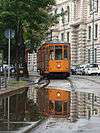Brescia Metro
|
| |||
|
| |||
| Overview | |||
|---|---|---|---|
| Native name | Metropolitana di Brescia | ||
| Locale | Brescia, Lombardy, Italy | ||
| Transit type | Rapid transit | ||
| Number of lines | 1[1] | ||
| Number of stations | 17[1] | ||
| Daily ridership | 44,100 (2015)[2] | ||
| Annual ridership | 16.1 million (2015)[2] | ||
| Website | Brescia Mobilità | ||
| Operation | |||
| Began operation | 2 March 2013[3] | ||
| Operator(s) | Brescia Mobilità S.p.A. | ||
| Number of vehicles | 18 AnsaldoBreda Driverless Metro | ||
| Train length | 3 cars | ||
| Headway | 4–10 minutes | ||
| Technical | |||
| System length | 13.7 km (8.5 mi)[1] | ||
| Track gauge | 1,435 mm (4 ft 8 1⁄2 in) standard gauge | ||
| Top speed | 80 km/h (50 mph)[4] | ||
| |||
The Brescia Metro (Italian: Metropolitana di Brescia)[5] is a rapid transit network serving Brescia, Lombardy, Italy. The network comprises one line, 13.7 kilometres (8.5 mi) long, with 17 stations from Prealpino to Sant´Eufemia-Buffalora.[1] All 17 stations have platform edge doors.
History

The first projects for a metro in Brescia date back to 1980s, with the introduction of the first fully automatic light metro systems in other mid-size cities in Europe. Two feasibility studies were commissioned in 1987. The automatic light metro system was chosen as the best technology for the city. The first public tender was announced in 1989. But this project was then cancelled in 1996.
In 1994, the first application for public financing was issued. The public financing form the central government arrived in 1995, while other funds arrived in 2002 from the Region. The international public bid for the first phase of the project was announced in 2000. The winning proposal was from a group of companies comprising Ansaldo STS, AnsaldoBreda, Astaldi and Acciona, with a system similar to that of the Copenhagen metro.
A €575 million contract was awarded to a consortium led by Ansaldo STS in April 2003.[4] Work started in January 2004, but archaeological finds caused delays and required station redesigns. The line opened on 2 March 2013.[3][6]
Rolling stock
The AnsaldoBreda Driverless Metro trains are the same as those on the Copenhagen Metro.[7] Trains are divided into three cars, 39 m long in total.
With 18 vehicles currently in operation, the maximum ridership is 8,500 passengers per hour per direction, with a headway of 180 seconds.
Service
Service starts at 5:00 with the last train departing at 24:00. The service has been extended starting from the first year of operation (2 March 2014). Train frequencies vary from 10 minutes (off peak) to 4 minutes (weekdays peak hours)

See also
References
- 1 2 3 4 "Mappa della linea metropolitana" (PDF) (in Italian). Brescia Mobilitá. Retrieved 2013-11-07.
- 1 2 "Trasporto pubblico locale" (in Italian). comune.brescia.it. Retrieved 18 January 2016.
- 1 2 "Parte la metro! 2 marzo 2013" [The Metro goes! 2 March 2013] (in Italian). Brescia Mobilitá. 5 February 2013. Retrieved 2013-10-11.
- 1 2 Francesco Di Maio (April 2008). "Automation in a medium-sized city". Railway Gazette International.
- ↑ "LA METROPOLITANA DI BRESCIA". Brescia Mobilità. Retrieved 2 August 2013.
- ↑ "La metro di Brescia apre sabato 2 marzo" [The Brescia Metro opens 2 March]. CityRailways.it (in Italian). 5 February 2013. Retrieved 15 February 2013.
- ↑ "Airport extension completes København Metro". Railway Gazette International. 2007-09-30. Retrieved 15 February 2013.
External links
| Wikimedia Commons has media related to Brescia light metro. |
- Brescia Metro - official site (Italian)
